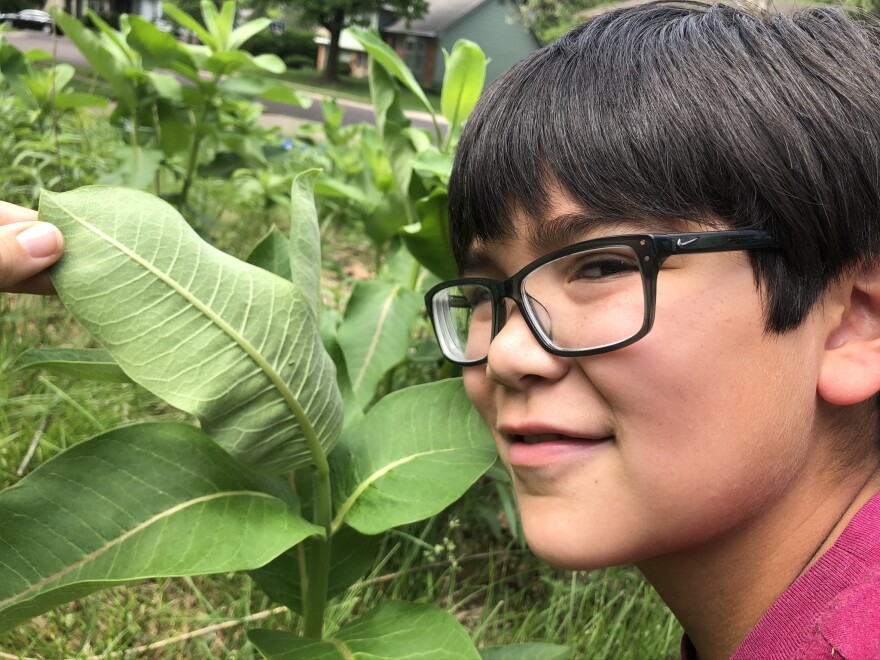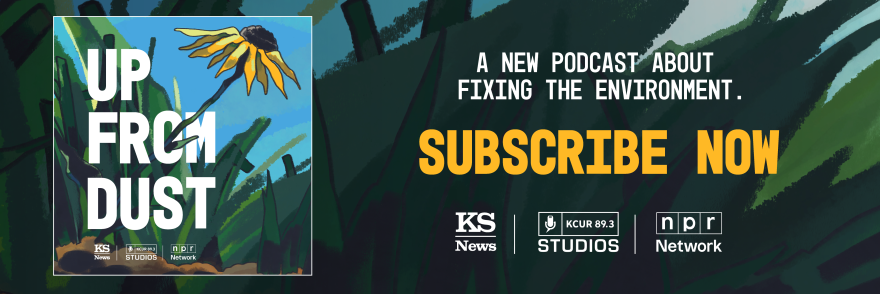KANSAS CITY, KANSAS — Oliver Faulkner looks around this city and sees too much gray. Buildings and pavement.
“It’s just … a lot of city,” they said.
Or, when they spot some green, often it’s little more than manicured lawn. That doesn’t cut it.
“You can just plant a few plants and say it’s green,” Faulkner said, “but if it’s not actually being used by the nature around it, it kind of is doing the same thing as a building would.”
Instead, they want a stroll through any Kansas City, Kansas, neighborhood to offer flowers, native grasses, insects and respite from the summer heat.
“I want to see at least one bug,” they said. “I like places that at least have some sort of shade.”
Incorporating more green into our cities contributes to cleaner air and bodies of water. It absorbs rain to take the load off of stormwater systems for less flooding. It helps cool heat generated by too much pavement, which is especially important as greenhouse gases warm the planet.
And green spaces — when done right — can do more. They can lower our stress levels, relax us and tempt us to exercise. They can bring people together to ease loneliness.
“Healthy planet, healthy people,” said Jenny Roe, a design and health professor at the University of Virginia’s School of Architecture.
Faulkner and several friends found a way to bring more of what they wanted to their own cityscape. A few years ago, while in high school, they joined the Green Team.
This program, run by grassroots nonprofit Groundwork Northeast Revitalization Group, improves public spaces in a demographically diverse corner of the Kansas City area that bears the weight of decades of racist policies.
“There are really a lot of overlapping crises,” said Mata Townsend, a Groundwork NRG communications and project coordinator. “It’s disenfranchisement and disinvestment for so long.”
Restorative experiences
Frustration drove Roe, an environmental psychologist, to move on from her career as a landscape architect. She had been working on improvement projects in economically disadvantaged parts of London.
“The budgets were always being cut,” she said. “And it grieved me that people in poor communities did not have access to the same quality landscapes that wealthier people in London have.”
Now she studies how landscaping affects human wellbeing and she says green spaces should offer visual intrigue and complexity.
“A lot of Americans think of nature as kind of ‘out there,’ in national parks,” Roe said. “Nature needs to be right at the heart of our cities for all sorts of reasons — health, sustainability, biodiversity.”
Plants of different heights, textures, colors and seasonal changes — and the movement and sounds of creatures such as bumblebees and song birds — all make green spaces more valuable.

“Green mown grass in suburbs is doing nothing for people’s mental health and wellbeing,” she said.
Variety fosters fascination, awe and wonder, said Roe, author of the book “Restorative Cities.” It offers distraction. It makes a walk outside a richer escape from the daily grind.
And, researchers say, it connects people.
“It improves your mood,” Roe said. “We’ve seen patterns in the brain linked to relaxation. We’ve seen patterns in body physiology linked to stress reduction.”
Her research has found links between living near green space and experiencing less stress.
Researchers at University of East Anglia’s medical school dug into 140 studies of health and green space. They found statistically significant links to better blood pressure and heart rates and to reducing physiological signs of stress, diabetes and heart-related deaths.
One 2008 study found that surrounding people with more nature correlated with reduced health inequality in low-income neighborhoods.
Physicians have begun prescribing exposure to nature. Scores of these prescription programs have popped up across the country.
A 2020 review of studies into such programs by researchers with the U.S. Forest Service and the University of Pennsylvania School of Medicine says the unconventional prescriptions are “motivated by a growing body of research demonstrating the health benefits of spending time in nature,” but studies remain too sparse to know how well they work.
Experts point out it’s not realistic to expect everyone to find the time or means to get to green and wild places far from their homes. Lower-income areas are less likely to include much public green space. This disproportionately affects people of color.
A sense of community
The Green Team and Groundwork NRG projects take their cue from community input. They beautify and preserve sites with local history, add tree canopy and flowers and replace invasive plants with native species to draw in pollinators and birds.
The work can be tiring, Gerardo Zapata said while digging a path for a gravel trail on a hot summer day. But a finished project washes him with feelings of satisfaction.
“There’s so many lots that now look so much better,” he said, adding that he has seen pollinators crowd the butterfly milkweeds that he and his friends planted in those places.
Zapata and his friends were helping the Turtle Hill Neighborhood Association jazz up a public spot with a patio, benches and flowers.
When he started working on his first lot after joining the Green Team, a man who lived across the street started lending a hand, even though he couldn’t communicate with the teenagers in a language they understood.
“He comes down every single week we go there to water and work on the lot,” Zapata recalled. “He has the biggest smile. … He comes to plant with us. He brings his children.”
A 2021 study in the International Journal of Epidemiology found a correlation between local green spaces and curbing loneliness.
An excuse to go outdoors opens opportunities for interactions.
“People will walk in neighborhoods — they will walk more frequently in neighborhoods that have these front yard greening initiatives,” Roe said. “And they will stop and talk to people.”

Bringing visual complexity to front yards
Roe advocates for expanding visually interesting, quality green spaces beyond just parks and community gardens.
She sees residential neighborhoods full of little more than lawns as a missed opportunity to improve community wellbeing.
And some city planners see it as a missed chance to curb stormwater runoff, erosion and pollution, and to increase neighborhood resilience to drought and heat.
The Mid-America Regional Council — an association of local governments in the Kansas City region — has published model city code ordinances that would foster more nature in our landscaping.
Johnson County and its cities reimburse residents who turn part of their lawns into rain gardens.
In Lawrence, a city panel recommended in 2022 that the city commission consider a similar cost-share program. And it asked the city to push developers away from planting so much turf — by requiring that 20% of non-paved ground in new developments feature native plants or well-maintained naturalistic landscaping.
Those recommendations stalled. In November, the panel voted again to ask city leaders for a narrower set of changes that would at least encourage native plants and naturalistic landscaping. The city commission hasn’t discussed the proposal yet.
“We’re not alone in this,” sustainability advisory board chairman Ben Sikes said at that meeting. “These are ordinances that have been passed in lots and lots of places.”
Earlier last year, Sikes drove through the city, pulling over occasionally to point out lawns and gardens. He passed a row of typical middle-class homes with manicured lawns in the Holcom area.
The street had trees, but little else.
“Underneath almost all of those is the same exact species of grass,” he said.
Short-clipped turf is great for some sports and the occasional lawn game, he said. But our cultural desire to surround every home with a lawn comes from centuries-old ideas held by European aristocrats. They wanted to prove they were rich enough to use their land for something other than farming.
Next, he pulled in front of a house where native, prairie grasses and flowers like wild bergamot occupied much of the yard.
A gripe from a neighbor could trigger a visit from a city code enforcer, even though the homeowners take care to maintain the plants.
“We need to pull back some of those regulations on height,” said Sikes, an ecologist. “Encourage people to plant native plants, and hopefully even have programs that help foster that.”
People who stray from the norm risk ruffling the feathers of neighbors who want to protect their home values and who feel that traditional lawns protect property values.
Ginger Werp’s decision to turn part of her Overland Park front yard into a mini meadow earned a visit from a city code enforcer, as the Kansas News Service reported last year.
Werp had to rip out some of the plants — but the city later revisited its codes. Now the suburb encourages residents to plant native wildflowers, shrubs and trees to support wildlife and manage stormwater.
To Werp, her mini meadow has another important benefit: delight.
She likes spotting swallowtail butterflies. She likes seeing her son, Oliver Hernandez, show his friends bugs and monarch caterpillars. She likes watching goldfinches painstakingly scour her garden for food.
It’s like having a bird feeder that she and her family never need to refill.
“The birds love it in the winter,” she said, pointing to the handiwork of finches on the previous summer’s spent blooms. “All the seeds have already been picked out of these.”
Former Kansas News Service reporter Blaise Mesa contributed reporting to this story.
Celia Llopis-Jepsen is the environment reporter for the Kansas News Service. You can follow her on Twitter @celia_LJ or email her at celia (at) kcur (dot) org.
The Kansas News Service is a collaboration of KCUR, Kansas Public Radio, KMUW and High Plains Public Radio focused on health, the social determinants of health and their connection to public policy.
Kansas News Service stories and photos may be republished by news media at no cost with proper attribution and a link to ksnewsservice.org.





